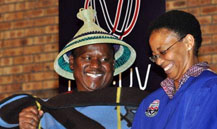Reverend Frank Chikane honours ‘Oom Bey’ at second Beyers Naudé Memorial Lecture for 2012
 |
Rev. Frank Chikane and Dr Choice Makhetha, Vice-Rector: External Relations at the UFS.
Photo: Stephen Collett
10 September 2012 |
The 9th Beyers Naude Memorial Lecture, a partnership initiative between the University of the Free State (UFS) and Kagiso Trust, was held on the South Campus of the university last week. The theme of the lecture focused on Collaborative partnership for social cohesion: Building of a nation with ethics.
Guest speaker, Reverend Frank Chikane, is a member of the UDF, ANC, Director-General in the Office of the President and a board member of Kagiso Trust.
In his speech, Rev. Chikane focused on the first 45 years in the life of Beyers Naudé, sketching a picture of a man who lived for what he believes in. When this former minister of the South African Dutch Reformed Church and member of the Broederbond, decided to question the morality of the Apartheid government after the Sharpeville Massacre in 1960, he made some changes in his beliefs and started to play a big role in the struggle against apartheid.
“If one know about ‘Oom Bey’s’ earlier life, you will see how radical his contribution was in turning South Africa from a country on the brink of destruction to a country of peace. ‘Oom Bey’ must be seen as a role model, someone we can aspire to be in South Africa today,” Rev. Chikane said.
“From his legacy one sees elements of someone building a nation with ethics.
“He took sides with the poor against an unjust system. Power breaks cohesion. It makes people not to think,” Rev. Chikane said.
If Afrikaners and black people stood together after the South African War (Anglo-Boer War), we would have talked a different language today. However, they did not. Afrikaners stood together, excluding black people and cohesion between all races was destructed. ‘Oom Bey’ tried to build relationships between people from all races in South Africa in an effort to create peace amongst all people. He was alienated from the Broederbond and defrockedrom the church.
In his speech, Rev. Chikane also said that South Africa did not succeed in collaborative partnerships in terms of the economy. “We need collaborative action to change our economy. This specific failure can destroy all that we have built together.”
“All South Africans can be like ‘Oom Bey” and make a contribution, especially in terms of the economy. To deal with this challenge, we can all contribute. This is important because due to a poor economy, many people are desperate and desperate people can destroy any relationship that we might have built so far.”
At this event, the university and Kagiso Trust also announced the winners of a poetry and essay competition that coincided with this last Beyers Naudé lecture for 2012. The award ceremony looked at the creativity of the learners, how they expressed themselves as well as the novelty of their work. Students as well as learners from schools in the Free State participated in the competition and first, second and third place winners received cash prizes as well as a book from Rev. Frank Chikane for their brilliant work.